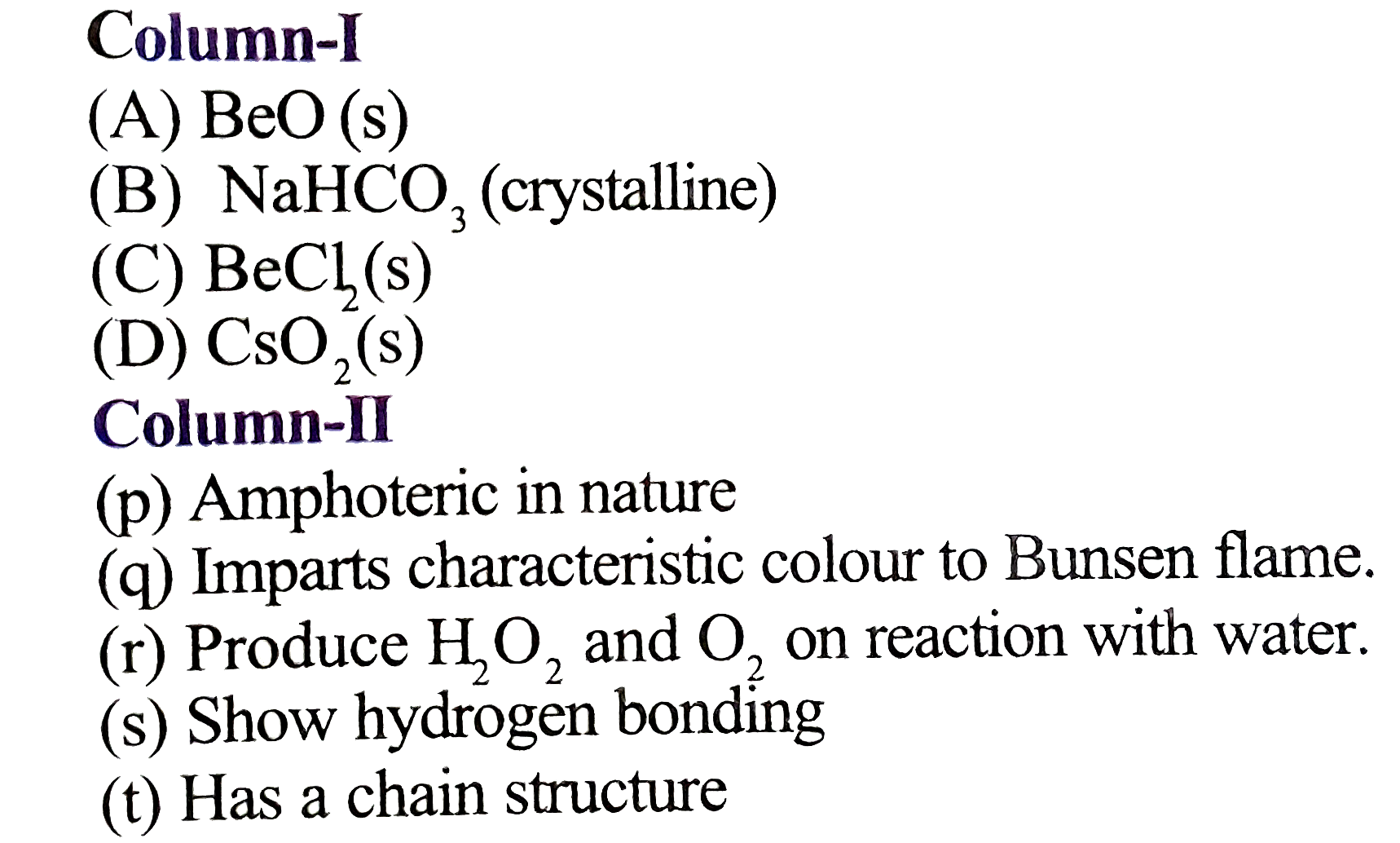Match the no. of moles listed in Column I with their relevant amounts listed in Column II.

The correct Answer is:A→q,t;B→p;C→r;D→s
A→q,t,B→p,C→r,D→s
(A) ∵ 2g = 1 mole
∴ 2000 mg = 1 mole
(∵1g=1000mg)
∴200mg=12000×200=0.1 mole
(A) ∵ mass of 1 g Fe atom = 56 g = 1 mole
So mass of 0.1 g Fe atom =561×0.1=5.6g
∵ mass of 1 g Fe atom = 1 mole (GAM of Fe)
∴ mass of 5.6 g Fe atom = 0.1 mole
(B) ∵ 22400 ml of CO2 at STP = 1 mole of CO2
∴ 4480 ml of CO2 at STP
=122400×4480=0.2 mole of CO2
(C) ∵6.02×1023 molecules of O2 gas =1 mole of O2 gas
∴1.5×1023 molecules of O2 gas
=16.02×1023×1.5×1023
=0.25 mole of O2 gas
(D) ∵ 18 g of water =1 mole
∴ density of water =1 g/ml
and mass of water =18g
∴v=md=18g1g×ml
=18 ml
Thus, 18 ml of water = 1 mole
∴ 9 ml of water =118ml×9 ml
=0.5 mole.
Topper's Solved these Questions
- SOME BASIC CONCEPTS OF CHEMISTRYBOOK - ERRORLESS CHAPTER - SOME BASIC CONCEPTS OF CHEMISTRYEXERCISE - JEE Section (Integer type questions)
16 Videos
- SOLUTION BOOK - ERRORLESS CHAPTER - SOLUTION EXERCISE - JEE SECTION (JEE (Advanced)2018) (Numeric answer type questions)
3 Videos
- THERMODYNAMICS AND THERMOCHEMISTRY BOOK - ERRORLESS CHAPTER - THERMODYNAMICS AND THERMOCHEMISTRY EXERCISE - JEE section (JEE (Advanced) 2018) Numeric answer type questions
2 Videos
Similar Questions
The oxidation number of Mn in the product of alkaline oxidative fusion of MnO2 is
View SolutionLiquids A and B form ideal solution over the entire range of composition. At temperature T, equimolar binary solution of liquids A and B has vapour pressure 45 torr. At the same temperature, a new solution of A and B having mole fractions xAandxB, respectively, has vapours pressure of 22. torr. The value of xA/xB in the new solution is ______.
(Given that the vapour pressure of pure liquid A is 20 torr at temperature T).
View SolutionThe surface of copper gets tarnished by the formation of copper oxide. N2 gas was passed to prevent the oxide formation during heating of copper at 1250 K. However, the N2 gas contains 1 mole % of water vapour as impurity. The water vapour oxidises copper as per the reaction given below: 2Cu(s)+H2O(g)→Cu2O(s)+H2(g) is the minimum partial pressure of H2 (in bar) needed to prevent the oxidation at 1250 K. The value of ln is ____. (Given: total pressure = 1 bar, R (universal gas constant) = 8JK−1mol−1,ln(10)=2.3.Cu(s)andCu2O(s) are mutually immiscible. At 1250 K:2Cu(s)+1/2O2(g)→Cu2O(s)
△Hθ=−78,000Jmol−1
H2(g)+1/2O2(g)→H2O(g),△Gθ=−1,78,000Jmol−1, G is the Gibbs energy
View SolutionMatch the compounds listed in column -I with the characteristic(s) listed in column-II.

View SolutionMatch the scientists listed under column 'I' with ideas listed Column 'II'
View SolutionMatch the extraction processes listed in column I with metals listed in column II.

View SolutionMatch the complexes listed in column-I with characteristic(s) listed in column-II.
View SolutionMatch the extraction processes listed in column I with metals listed in column II.

View SolutionMatch the reactions listed in column-I with the products listed in column-II

View SolutionMatch the reactions listed in column-I with the products listed in column-II
View SolutionMatch the reaction products listed in column-I with the particulars listed in column-II
View SolutionMatch the compound listed in Column I with characteristic listed in Column II
View SolutionMatch the list of items of Column I with Column II-
View SolutionMatch the list of items of Column I and Column II and select the correct match.

View SolutionMatch the etraction processes listed in column-I with metals listed in column-II
View SolutionMatch the animals listed in column-I to blood listed in column-II
View Solution
